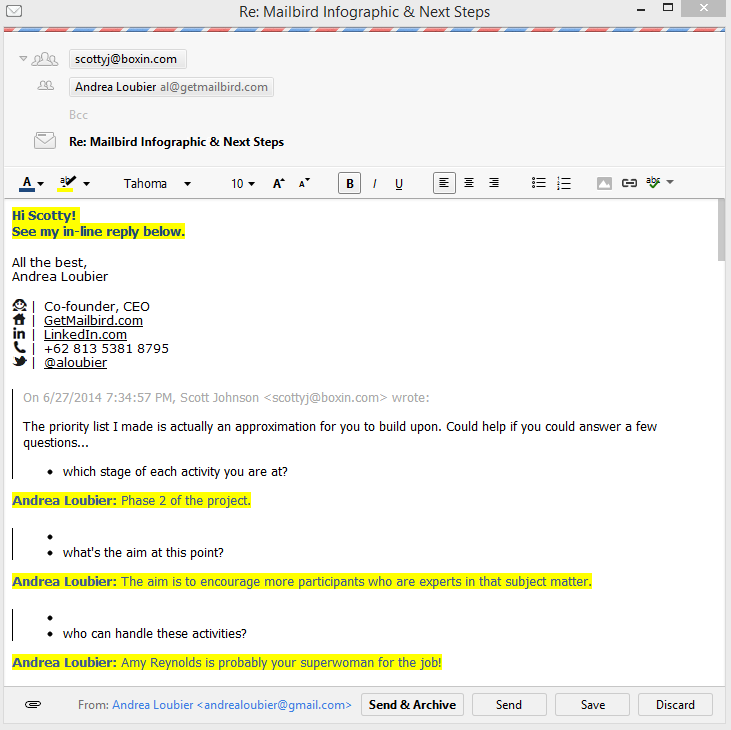“This could change your inbox forever.”
To just say “keep your emails short” really isn’t specific enough for you to actually follow this piece of inbox management advice. Instead we invite you to the 5 sentence email challenge, meaning emails you compose or reply to should not be more than 5 sentences long.
Free up more time in your work day to stay productive, improve how you communicate, while influencing better and less frequent emails in your inbox.
In our last Blog post titled “Email, it’s not so bad.” we mention the 5 Sentence Email Rule as tip #6. This is a brilliant philosophy and takes some practice. It all falls back to how email is mismanaged today, and new thing we can do to make it much better for us. According to the August 14, 2014 post on The Atlantic, “Email is still the best thing on the internet” so let’s see how we can evolve with the fast ever-changing environment of information exchange, so it isn’t such a hassle to manage the constant influx of electronic messages flooding our inbox.
5 Sentence Email?
We investigate the 5 sentence email strategy to see if it is appropriate for business email correspondence. The easy answer is, that there is no definite rule when handling new emails or when replying to emails. Simply take the time to consolidate info in your emails to 5 sentences or less. By Guy Kawasaki’s standard (the man who coined the 5 sentence email philosophy), you can easily do this by answering…
1) Who are you?
2) What do you want?
3) Why are you asking me?
4) Why should I do what you’re asking?
5) What is the next step?
Guy says, “This is all an intelligent person needs to know to make a decision.”
There are many circumstances where limiting your emails by number of sentences is too restrictive depending on the nature of information you are communicating, but not if you can answer the 5 questions above. The idea here is to eliminate a ton of back and forth, and to answer all the potential questions and offer suggestions to the person you are emailing. You can even include in your email signature to encourage this new email culture and habit explaining you are improving your efficiency and productivity with short emails using 5 sentences or less, and request the response is also 5 sentences or less. Or, just use this 5 Sentences email tool. Then of course there are exceptions for the extra details.
Leaving out the extra details.
What do we mean by extra details? Which ones can you leave out and which ones are ok to keep, even if it exceeds the 5 sentence strategy? Well some emails require a lot of specific information needed for the email recipient to take the next steps – again referencing question #5 above. In this case, give all the necessary info directly and succinctly. The details you can always keep include any kind of positive encouragement, praise or recognition of the recipient’s hard work and good will. You also can never say thank you enough, and this all ties into our strong belief in integrating happiness in our work and personal lives.
Why do it?
The great thing about keeping emails short, especially if you are a small business looking to utilize email marketing, is that you are much more likely to engage with the person you are emailing and get a clear response and action. Many of us have a bad habit of writing out our thought process in emails, I even do it. If that is your process, so be it. However it is necessary to then take the next steps and re-read your email and see how you can cut it down to a clear conclusion and ensuring you directly answered the 5 questions. Even better if you can achieve this in less than 5 sentences.
The recipient of your email does not need to spend their time reading through your convoluted thought process, save them and yourself time by keeping emails short and to the point with direct action and next steps. Communicate what the recipient needs to know, cut the extra email “fat” (a.k.a. unnecessary filler sentences) with a well thought-out and very clear way of communicating via email. Remember, it’s just email and it’s still the best thing on the internet. Reduce the time you spend emailing when you follow this email management strategy – it’s awesome! You’ll see the difference right away. We promise.
No, this isn’t for me!
Now for those of you who turn your head at this strategy, the Mailbird team knows, old habits are hard to break. So what we’ve done for you took the extra time and care to help you effectively reply to emails with Mailbird’s special In-line Reply feature. If you don’t have time to thoughtfully cut your emails to 5 sentences or less, then using this kick ass email client, you can reply directly to all pertinent points with In-line Reply. It’s a win-win for you and the person you email, making life easier with fast, convenient and well organized email replies.
We hope this helps you stay focused so you get email done, keeps your inbox under control and your communication much more effective while building a much healthier relationship with your email.
Tell us your “short email” strategy.
Have you tried other clever short email strategies? If so, share with us in the comments below what works and what does not for you.
If you don’t think the short email movement is the way to go, then try the In-line Reply feature in Mailbird and tell us what you think about it’s effect on your focus, productivity and efficiency in email communication below.






























